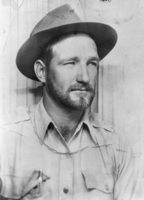Search the Special Collections and Archives Portal
Search Results
Centennial Stories: Examining Our Past, "L.V. Strip Howard Hughes Era," CCTV-4 Clark County TV, 2009
Level of Description
Scope and Contents
Additional information from donor: Moderated by Mark Hall-Patton. Paul Winn, Geoff Schumacher, and Burton Cohen reflect on the impact Howard Hughes had on Las Vegas. Additional contribution by Bob Stoldal in video segments.
Archival Collection
Collection Name: Scott Rayer Collection of Television Programs about Las Vegas, Nevada
Box/Folder: Digital File 00
Archival Component
Series V. Hughes Tool Company, 1912 to 1990
Level of Description
Scope and Contents
The Hughes Tool Company series (1912-1990) encompasses the administrative, financial, and legal management of Hughes Tool Company. Materials within the series depict Howard Hughes' control of the company; his film, aeronautics, electronics, and real estate ventures; and his lawsuits and United States Senate hearing. The series also includes research reports on the corporate history of Hughes Tool Company and its subsidiaries, copyright histories for films Hughes produced, and correspondence from Hughes' associates searching for reels of Hughes' films domestically and internationally.
Archival Collection
Collection Name: Howard Hughes Film Production Records
Box/Folder: N/A
Archival Component
Howard Heckethorn oral history interview
Identifier
Abstract
Oral history interview with Howard Heckethorn conducted by Neil Dalmas on March 02, 1977 for the Ralph Roske Oral History Project on Early Las Vegas. This interview offers an overview of early education in Nevada. Mr. Heckethorn also discusses Stewart Ranch, Howard Hughes and the Hughes Site, and the migration of the Mormons to the Las Vegas area.
Archival Collection
Howard Hughes' inventory of Scarface reels, includes domestic and international requests to find undamaged reels for Hughes' private viewing, 1955 November 03 to 1972 June 02
Level of Description
Archival Collection
Collection Name: Howard Hughes Film Production Records
Box/Folder: Box 377 (Restrictions apply)
Archival Component
Howard R. Hughes College of Engineering: Mero Structures, Inc. correspondence, product samples, subcontracts, and electrical details, 1988
Level of Description
Archival Collection
Collection Name: J. A. Tiberti Construction Records
Box/Folder: Box 095
Archival Component

Leon Hughes, son of John R. Hughes, on the Pahrump Ranch, Nevada: photographic print
Date
Archival Collection
Description
From the Nye County, Nevada Photograph Collection (PH-00221) -- Series IV. Pahrump, Nevada -- Subseries IV.A. Hughes Family. John Hughes was then the owner of the ranch.
Image
"Las Vegas, Nevada Selected Real Estate Holdings, the Estate of Howard R. Hughes, Jr.", booklet, 1980 November
Level of Description
Archival Collection
Collection Name: Thomas L. Morgan Real Estate Development Records
Box/Folder: Box 37
Archival Component
Tom Morgan to Ron Boeddeker, partial letter discussing land acquisition by Howard Hughes, 1996 November 06
Level of Description
Archival Collection
Collection Name: Thomas L. Morgan Real Estate Development Records
Box/Folder: Box 15
Archival Component
Hughes HK-1 Hercules photographs, 1945-1947
Level of Description
Scope and Contents
Materials contain photographs of the HK-1 Hercules, otherwise known as the "Spruce Goose" or the "Flying Boat," from 1945 to 1947. The photographs primarily depict the construction, transportation, and storage of the plane, but also include the first and only test flight of the HK-1 above Los Angeles Harbor in 1947. Howard Hughes designed the HK-1 as the world's largest plane, capable of transporting large quantities of U.S. military hardware and personnel. In 1947, under the program's new designation H-4 Hercules, Hughes had the plane transported from his factory in Culver City, California to Los Angeles Harbor. On November 2, he piloted the plane during its only test flight. The U.S. Air Force abandoned the controversial project, and Hughes was called to testify before the Truman Committee of the U.S. Senate to justify the use of government funds on a program that never succeeded.
Archival Collection
Collection Name: Howard Hughes Public Relations Photograph Collection
Box/Folder: N/A
Archival Component
